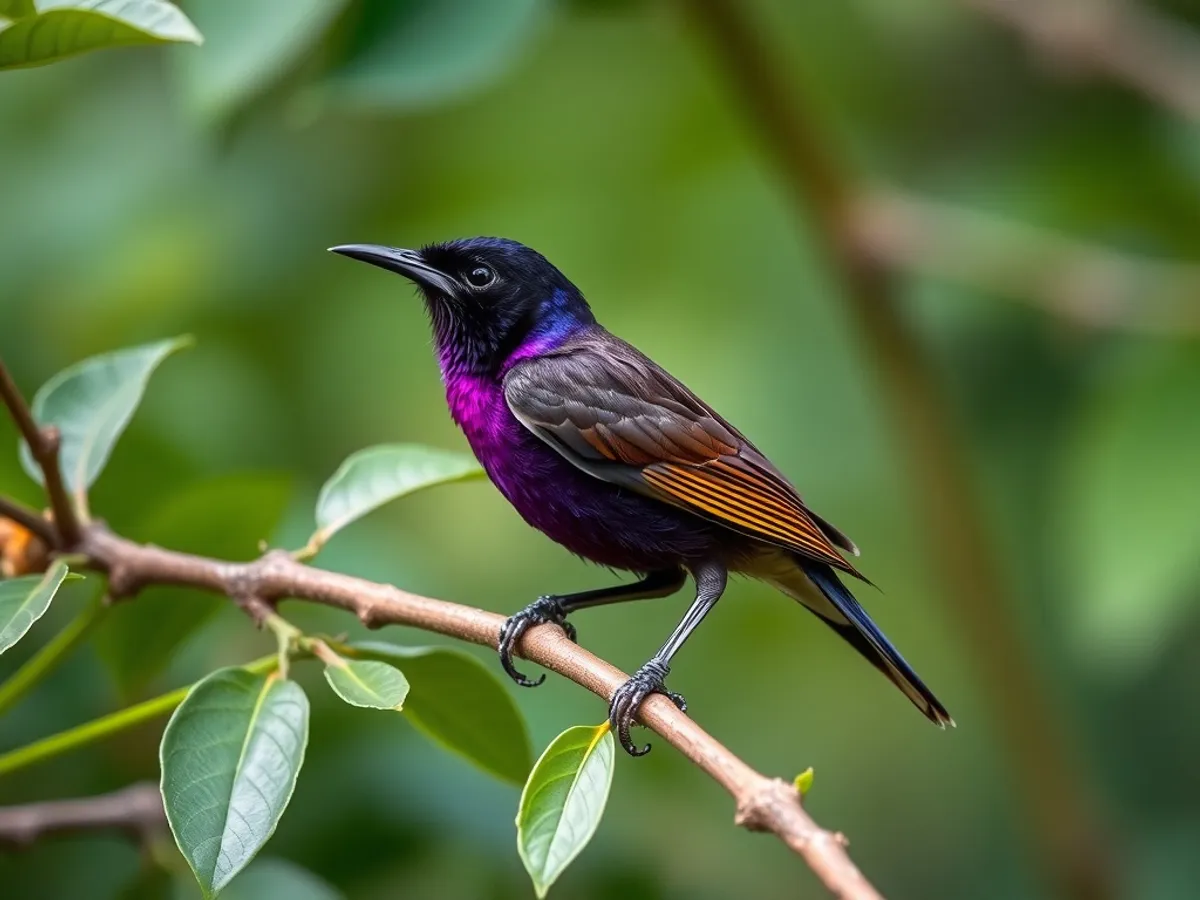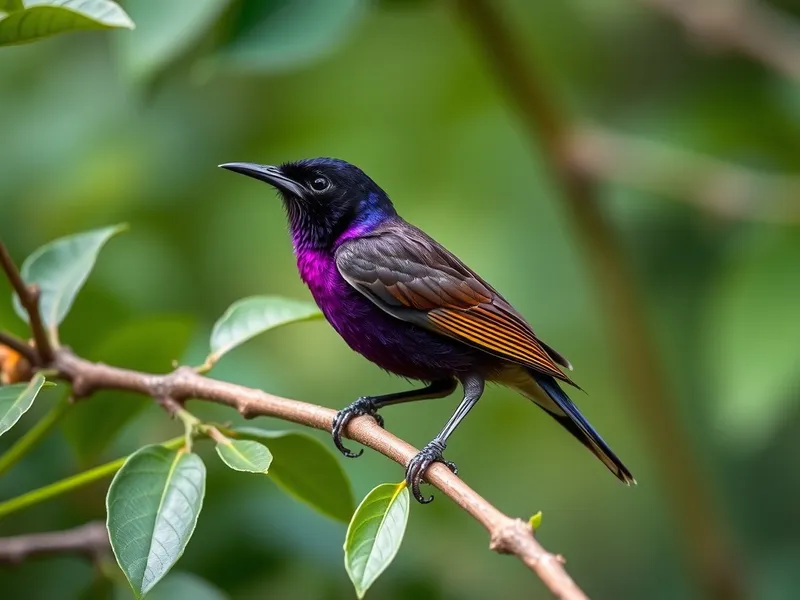
Purple Sunbird
Cinnyris asiaticus

Meet the Purple Sunbird
The Purple Sunbird is a small, vibrantly colored passerine bird native to South and Southeast Asia. Males display striking, iridescent purple-blue plumage during the breeding season, while females are olive-yellow, providing excellent camouflage. Agile and energetic, these birds are often seen hovering like hummingbirds while feeding on nectar, although they can also perch to feed. Their rapid, high-pitched songs and swift movements make them a lively presence in gardens, forests, and urban areas alike. Adaptable and resilient, Purple Sunbirds thrive in a wide range of habitats, from rural woodlands to bustling city parks.
Classification
Bird
Habitat
Tropical and subtropical open forests, gardens, and urban areas
Diet
Omnivore
Lifespan
5-8 years
Conservation
Least Concern
Weight
5-10 grams
📖Fascinating Facts
Unique Nests
Purple Sunbirds build intricate, hanging purse-shaped nests using grass, spider webs, and plant fibers, often suspended from thin branches.
Expert Pollinators
While feeding on nectar, Purple Sunbirds inadvertently transfer pollen between flowers, making them important pollinators in their ecosystems.
Melodious Calls
They communicate with a variety of high-pitched, rapid songs and calls, especially during the breeding season to attract mates and mark territory.
📋Detailed Description
The Purple Sunbird (Cinnyris asiaticus) is a diminutive passerine, measuring 8–10 cm in length and weighing approximately 5–10 grams. Males in breeding plumage exhibit a striking, metallic iridescence with hues of deep violet, blue, and purple, while non-breeding males and females display more subdued olive and yellow tones, aiding in camouflage. The species possesses a slender, decurved bill adapted for nectar feeding, and a brush-tipped tongue specialized for extracting nectar from tubular flowers. Their wings are short and rounded, enabling rapid, agile flight and brief hovering similar to hummingbirds, though they more commonly perch while feeding. The tail is relatively short and square. Purple Sunbirds are highly vocal, producing a variety of high-pitched, rapid calls and complex songs, especially during the breeding season. Their eyes are dark, and the legs and feet are adapted for grasping thin branches and flower stalks. These birds are diurnal and exhibit pronounced sexual dimorphism, with males being more vividly colored than females. Their adaptability allows them to thrive in a wide range of habitats, from dense forests to urban gardens, and they are often observed in close proximity to human habitation.
💡 Did you know?
Despite their tiny size, Purple Sunbirds are capable of long-distance flights and can adapt to heavily urbanized environments.
🔬Research & Sources
Wikipedia Summary
The purple sunbird is a small bird in the sunbird family. It occurs in parts of the Arabian peninsula and South and Southeast Asia. It has a fast and direct flight and can take nectar by hovering like a hummingbird but often perches at the base of flowers. It feeds mainly on nectar and insects, especially when feeding young. The males can appear all black in harsh sunlight but the purple iridescence is visible on closer observation or under good light conditions. Females are olive above and yellowish below.
Last Modified: 1/14/2025
🎭Behavior & Social Structure
Purple Sunbirds are primarily nectarivorous, foraging actively throughout the day and visiting a wide variety of flowering plants, including native species and cultivated ornamentals. Their feeding behavior includes both hovering and perching, with a preference for perching when possible to conserve energy. In addition to nectar, they supplement their diet with small insects and spiders, especially during the breeding season when protein requirements are higher. Sunbirds are territorial, with males defending feeding and nesting territories through song and aerial displays. Socially, they are generally solitary or found in pairs, but may form loose aggregations at abundant food sources. They are known for their rapid, direct flight and agility among foliage. Roosting occurs singly or in pairs, often in dense vegetation. Daily routines involve early morning and late afternoon feeding peaks, with periods of rest during the hottest part of the day.
👶Reproduction & Life Cycle
Breeding occurs primarily during the spring and summer months, with timing varying regionally according to rainfall and flower availability. Males perform elaborate courtship displays, showcasing their iridescent plumage and singing to attract females. Nests are intricately woven, purse-shaped structures suspended from thin branches or human-made supports, constructed by the female using plant fibers, spider webs, and soft materials. Clutch size typically ranges from 2 to 3 eggs, which are pale and speckled. The female incubates the eggs for about 15–17 days, while the male may assist in territory defense. After hatching, both parents participate in feeding the chicks a diet rich in insects. Fledging occurs approximately 15–18 days post-hatching. Multiple broods may be raised in a single breeding season if conditions are favorable.
🛡️Adaptations & Survival
Purple Sunbirds exhibit several key adaptations for nectarivory, including a long, decurved bill and a specialized, brush-tipped tongue for efficient nectar extraction. Their iridescent plumage in males serves both as a sexual signal and as camouflage among sun-dappled foliage. The ability to hover, though less developed than in hummingbirds, allows access to flowers that cannot support their weight. Behavioral flexibility enables them to exploit a wide range of habitats, including urban environments. Their rapid metabolism and high activity levels are supported by frequent feeding. The construction of suspended nests helps deter ground-based predators and parasitism.
📚Research Sources
🎨Cultural Significance
Purple Sunbirds are celebrated in South Asian cultures for their vibrant appearance and lively presence in gardens, often symbolizing beauty, vitality, and the arrival of spring. They feature in local folklore and are sometimes depicted in art and poetry. Their role as pollinators enhances their ecological and cultural value, contributing to the health of both wild and cultivated plants. In some regions, their presence is considered auspicious, and they are a favorite among birdwatchers and nature enthusiasts.
🔬Recent Research & Discoveries
Recent studies have focused on the Purple Sunbird’s role as a pollinator in both natural and agricultural ecosystems, highlighting their importance in maintaining plant diversity. Research into their vocalizations has revealed complex song structures and regional dialects, suggesting advanced communication and potential for mate selection. Genetic analyses have clarified their phylogenetic relationships within the Nectariniidae family, supporting the current taxonomic placement in the genus Cinnyris. Ongoing research includes the impact of urbanization on their breeding success and foraging behavior, as well as the physiological mechanisms underlying their iridescent plumage.
🎥Wildlife Videos

The Incredible World of SUNBIRDS - Part Of The Flock Ep. 5 | Nature Documentary & Bird Photography
In Episode 5 of Part of the Flock, titled "All the Little Things", we'll delve into the fascinating nesting ethology of the Purple-Rumped ...
Kenneth Lawrence

Purple sunbird | animal documentary | wildlife photography | Nature videos | bird documentary
birds #nature #wildlife.
Divine Wildlife

Nature's Precision: Purple Sunbird Snatching Insects on the Fly
Cinnyris asiaticus.
Life On Planet Earth

Bird Videos | Shiny Purple Sunbird in Indian garden | Humming Bird | Wildlife
Check out Bird Videos. Its a Shiny Purple Sunbird in Indian garden called Humming Bird. Stay tuned to Wildlife for more on Bird ...
wildlife

Purple Sunbird Habitats / Male Purple Sunbird / Purple Sunbird Documentary / Sunbird Videos / Birds
Unlike many hummingbird species, sunbirds have brightly colored, sometimes iridescent feathers. The tongue of the sunbird is ...
Charismatic Planet

The Worlds Bio Nature Beautys |Birds| Purple Sunbird| Cinnyris asiaticus|
WILDLIFE ZONE Welcome dear friends subscribe our channel and enjoy wildlife video Thankyou... We live on the most beautiful ...
Wildlife Zone
🌍Habitat Information
The Purple Sunbird typically inhabits Tropical and subtropical open forests, gardens, and urban areas environments. Purple Sunbirds have adapted to their environments with specialized features and behaviors.
Primary Habitat:
Tropical and subtropical open forests, gardens, and urban areas
More detailed habitat information will be available soon.
🛡️Conservation Status
The Purple Sunbird is currently classified as Least Concern. Conservation efforts are crucial for preserving this species for future generations.
Common Threats:
- 🏠Habitat loss and fragmentation
- 🌡️Climate change impacts
- 🎯Hunting and poaching
- 🏭Human-wildlife conflict
⚠️Threats & Conservation Challenges
Currently assessed as Least Concern by the IUCN, Purple Sunbirds maintain stable populations across their extensive range. However, localized threats include habitat loss due to urbanization, pesticide use reducing insect prey, and competition with invasive species. In some areas, nest predation by birds, mammals, and reptiles poses a risk. Despite these challenges, their adaptability to human-altered landscapes and generalist feeding habits contribute to their resilience. Ongoing monitoring is necessary to detect potential declines, especially in rapidly urbanizing regions.
🔬Scientific Classification
Scientific Name
Cinnyris asiaticus
Classification Hierarchy
🔍 About Taxonomic Classification
Taxonomic classification is a hierarchical system used by scientists to classify and organize living organisms based on shared characteristics and evolutionary relationships.
The system moves from broad categories (Kingdom) to increasingly specific ones, with each animal's scientific name typically consisting of its Genus and species.
📝Community Notes
Share your observations and insights about the Purple Sunbird with our community of wildlife enthusiasts.
Join Our Community
Sign in to share your observations and connect with fellow wildlife enthusiasts.
Sign In to ContributeNo community notes yet
Be the first to share your observations about the Purple Sunbird!
Explore Purple Sunbird
Select a tab above to learn more about this amazing animal.
📸Photo Gallery
No photos available for this animal yet.
🌟Discover More Wildlife
Continue your journey of discovery with more fascinating animals from our database
